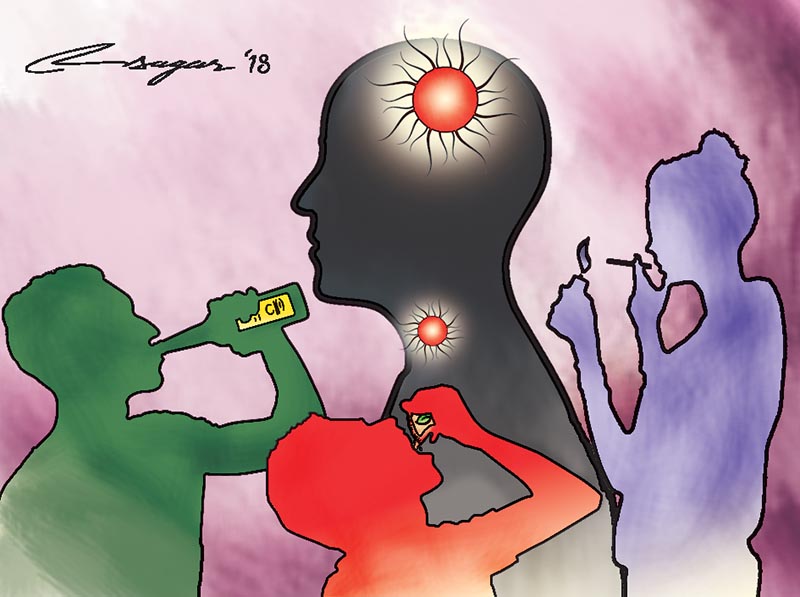Head and neck cancer: A major disease burden
Prevention is the key to decreasing burden of this disease. Increasing awareness in public about tobacco as main cause of head and neck cancer will be the most single bold step. Healthy lifestyles and early referrals also need to be encouraged
World Head & Neck Cancer Day is observed every year across the world on July 27. In Nepal also, we observed the day with various programmes including awareness, meeting with survivors, forming Head & Neck Cancer Support Group, organising continued medical education (CME) focusing on head and neck cancer management, where caregivers involved in this speciality participated from national and international level.
Head and neck cancer is a group of cancers of various subsets involving body part from the lowermost neck up to the skull base (bone separating sinus from the brain). It includes mouth, larynx (voice box), throat, nose and sinus, ear, skin cancer of face, thyroid, salivary gland and lymph node of neck. It is three times more common in males than females. Though no age group is immune to it, it is more common among those who are 40 years or above.
In other part of the world it is considered to be the fifth most common malignancy, but in Nepal and other South Asian countries, it is considered to be one of the most common cancers in males and third most common cancer (after cervical and breast) in females. Though we don’t have concrete data due to lack of national cancer database, based on available data we can assume that 3,500- 5,000 Nepali people lose their lives annually to head and neck cancer.
More than 7,000-8,000 new cases of head and neck cancer are detected every year, among which 80 per cent are sent to the referral centre at an advanced stage. Around 70 per cent of head and neck cancer patients belong to a lower socioeconomic status group.
Nearly 80 per cent of head and neck cancer cases are related to consumption of tobacco, areca nut and alcohol.
Especially with the advent of chewable form of tobacco (khaini, guthkha, paan), there has been an alarming rise of oral cancer cases in the Tarai region. Unfortunately, these causative agents are easily available either due to weak policy or poor implementation – or absence of any policy for this in our country.
Addiction to these forms of tobacco in a very young stage of life has increased the prevalence of head and neck cancer in younger age group. People who smoke and drink simultaneously have higher chances of acquiring head and neck cancer than who either smoke or drink only. Poor oral hygiene, ill-fitting denture and sharp tooth are other but less common causes of mouth cancer. Detecting disease in the early stage is the key to management of head and neck cancer.
Patients come up with various site-specific symptoms like a non-healing ulcer in mouth, difficulty in swallowing, voice change, swelling in the neck, mobile tooth, non-healing of wound post tooth extraction, ill-fitting dentures, one-sided facial swelling, increase in size of mole and previous or new skin lesion with ulceration.
Diagnosis is established after performing a clinical examination, biopsy from ulcer and FNAC (fine needle aspiration cytology) from the palpable lump in neck. Further assessment and staging after tissue diagnosis is done by performing endoscopy and imaging which consist of CT scan, ultrasonography, MRI scans and sometimes PET scans which are now available in Nepal.
After final staging, multimodality team which consists of head and neck reconstructive surgeons, radiation oncologist and medical oncologist decides upon the treatment modality. Treatment modality mainly consists of surgery, radiation and chemotherapy.
In early stage (stage 1&2) disease, single modality is chosen which mostly consists of surgery and sometimes radiation. In advanced stage (stage 3&4) cases, more than one modality is applied.
Early stage disease has favourable prognosis while advanced stage disease has dismal prognosis.
Diseases which cannot be treated with curative intent are considered for palliative and supportive care.
In Nepal, as caregivers, we face a lot of challenges while treating head and neck cancer patients, mostly due to economic constraints, presentation to cancer centre in advanced stage and social stigma. There is also a tendency among the general public to seek treatment from faith healers instead of reaching out to doctors. This also complicates the situation. Some refuse surgery due to cosmetic and functional issues. The follow-up rate among the patients is also poor.
In Nepal there are only a few comprehensive cancer centres which are always overburdened with head and neck cancer patients. When it comes to manpower also, the country lags behind.
Prevention is the key to decreasing the burden of this disease. Increasing awareness in the public about tobacco as the main cause of head and neck cancer will be the most single bold step. Adopting a healthy lifestyle, regular checkups especially of patients who are chronic abuser of tobacco and its product, early referral system are few other steps which will help in decreasing the burden.
All modality of treatment with latest technology and expertise is available in Nepal and results are comparable to any other centre, so going abroad and getting treatment at higher costs is not necessary as this disease requires regular follow-up and social and emotional support.
Thakur is director of Head & Neck Oncology Programme at Nepal Cancer Hospital & Research Centre






